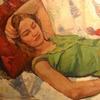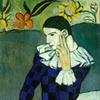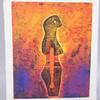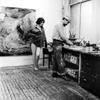Abstract Art by Black Women Artists from 1960s to Today at Women’s Museum in DC
- WASHINGTON, DC
- /
- September 06, 2017
Magnetic Fields: Expanding American Abstraction, 1960s to Today
October 13, 2017–January 21, 2018
First U.S. exhibition dedicated exclusively to the presentation of abstraction by an intergenerational group of black women artists
A landmark exhibition of abstract paintings, sculptures and works on paper by 21 black women artists will be on view at the National Museum of Women in the Arts (NMWA) Oct. 13, 2017–Jan. 21, 2018. Magnetic Fields: Expanding American Abstraction, 1960s to Today places the visual vocabularies of these artists in context with one another and within the larger history of abstraction. This exhibition celebrates those under-recognized artists who have been marginalized, and argues for their continuing contribution to the history and iconography of abstraction in the United States. Magnetic Fields is the first exhibition dedicated exclusively to the formal and historical dialogue of abstraction by black women artists.
From the brilliant colors and energetic brushwork of Alma Woodsey Thomas’s paintings to shredded tire sculptures by Chakaia Booker, works featured in this exhibition testify to the enduring ability of abstraction to convey both personal iconography and universal themes. The exhibition underscores the diversity of abstract art, which lies in its material construction and conceptual underpinnings, as well as in its practitioners.
Magnetic Fields features a range of works, including early and later career examples, several exhibited for the first time, and the long-awaited reappearance of iconic works such as Mavis Pusey’s large-scale painting Dejyqea (1970), featured in the Whitney Museum of American Art’s landmark 1971 exhibition Contemporary Black Artists in America.
“By highlighting each artist’s individual approach to materials, composition, color and content, Magnetic Fields creates a context for a lively and visual conversation among these artists,” said NMWA Director Susan Fisher Sterling. “The project also vigorously expands the art-historical narrative on post-war American abstract art. This exhibition shifts our attention to key practitioners who have not received their due, fostering a deeper appreciation of their accomplishments and asserting a new parity of value for their work.”
Magnetic Fields also pays tribute to the lived experience of each of the featured artists who have come individually to pursue abstraction, disrupting the presumption that only figurative works can convey personal experience. Collectively, work by the select group of prolific creators, born between 1891 and 1981, represents a range of approaches rooted in Abstract Expressionism, Color Field painting and Minimalism, with emphasis on process, materiality, innovation and experimentation. The artists in the exhibition are:
- Candida Alvarez (b. 1955)
- Chakaia Booker (b. 1953)
- Betty Blayton (b. 1937, d. 2016)
- Lilian Thomas Burwell (b. 1927)
- Nanette Carter (b. 1954)
- Barbara Chase-Riboud (b. 1939)
- Deborah Dancy (b. 1949)
- Abigail DeVille (b. 1981)
- Maren Hassinger (b. 1947)
- Jennie C. Jones (b. 1968)
- Evangeline “EJ” Montgomery (b. 1930)
- Mary Lovelace O’Neal (b. 1942)
- Howardena Pindell (b. 1943)
- Mavis Pusey (b. 1928)
- Shinique Smith (b. 1971)
- Gilda Snowden (b. 1954, d. 2014)
- Sylvia Snowden (b. 1942)
- Kianja Strobert (b. 1980)
- Alma Woodsey Thomas (b. 1891, d. 1978)
- Mildred Thompson (b. 1936, d. 2003)
- Brenna Youngblood (b. 1979)
“As curators, we are honored to present this incredible, intergenerational group of artists,” stated co-curators Erin Dziedzic and Melissa Messina. “This exhibition is intended to be a platform to further their visibility, as well as to generate more inclusive conversations about the history of American abstraction that consider the accomplishments and contributions of women artists of color going forward.”
The conceptual and formal connections among works in Magnetic Fields testify to the broad legacy of abstraction. Artists working across time and place share common aesthetics and impulses. For example, repetitive mark making, a bright color palette and cosmic references are found in Mildred Thompson’s Magnetic Fields (1991) triptych as well as Alma Woodsey Thomas’s Orion (1973). The kaleidoscopic merging of bright colors and organic forms in Betty Blayton’s paintings and prints finds kinship in the elements of Candida Alvarez’s paintings and drawings. Meanwhile, the use of carefully handled collage elements, shaped compositions and exquisitely subtle textures connects the works of Nanette Carter and Howardena Pindell.
Noticeably, younger artists in the exhibition, such as Abigail DeVille and Brenna Youngblood, who incorporate found objects with hints of representational imagery, find precedent in the torn pieces of postcard landscapes and bits of exhibition invitations imbedded in Howardena Pindell’s Autobiography: Japan (Shisen-dō, Kyoto) (1982). Such collage elements, seen throughout the exhibition, conceal and reveal fragments of representation, serving to blur the boundaries of pure abstraction.
Political undercurrents also flow throughout the exhibition. Mary Lovelace O’Neal’s use of provocative titles, as in Racism is Like Rain, Either it’s Raining or it’s Gathering Somewhere (1993), informs the reading of her monumentally scaled work. Maren Hassinger similarly uses socio-politically inflected titles and materials—specifically New York Times newspapers in her textural floor sculpture Wrenching News (2008). By twisting the newsprint, she makes its original text unreadable, evoking instead a sense of the warped perceptions surrounding media content.
“Magnetic Fields is an important and relevant project at a time when the art world is at last recognizing the contributions of women artists to the key moments in American art,” notes Lowery Stokes Sims, curator emerita, Museum of Arts and Design, and contributing author to the exhibition catalogue. “It not only expands the roster of artists working abstractly but also bravely tackles the quandary of black women artists who often have had to overcome familial uncertainty with their chosen careers, and have had to harness color, line and form to address the inevitable and unavoidable political and personal challenges they have faced in the world.”
Through its expansive scope, Magnetic Fields magnifies and intensifies the viewer’s perspective of American abstraction, and provides an expanded history of non-pictorial image- and object-making.
Magnetic Fields: Expanding American Abstraction, 1960s to Today is organized by the Kemper Museum of Contemporary Art, Kansas City, Missouri, and is supported in part by awards from the National Endowment for the Arts and from The Andy Warhol Foundation for the Visual Arts.
Magnetic Fields is on view at the Kemper Museum of Contemporary Art, June 8–Sept. 17, 2017.
Publication
Intergenerational in scope, Magnetic Fields: Expanding American Abstraction, 1960s to Today (Kemper Museum of Contemporary Art, 2017) includes 21 artists born between 1891 and 1981, among them Lilian Thomas Burwell, Mildred Thompson, Candida Alvarez, Betty Blayton, Nanette Carter, Brenna Youngblood and Jennie C. Jones. The 144-page illustrated catalogue features an introduction by NMWA Director Susan Fisher Sterling and essays by exhibition curators Erin Dziedzic and Melissa Messina, Valerie Cassel Oliver, Sydney and Frances Lewis Family Curator of Modern and Contemporary Art at the Virginia Museum of Fine Arts, Richmond, VA, and Lowery Stokes Sims, curator emerita of the Museum of Arts and Design, among others. It will be available in hardcover in the Museum Shop and online at http://shop.nmwa.org/ in October.

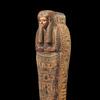



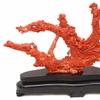


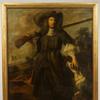
_Infinity_by_Santiago_Medina_PhotoCr100x100_c.jpg)

